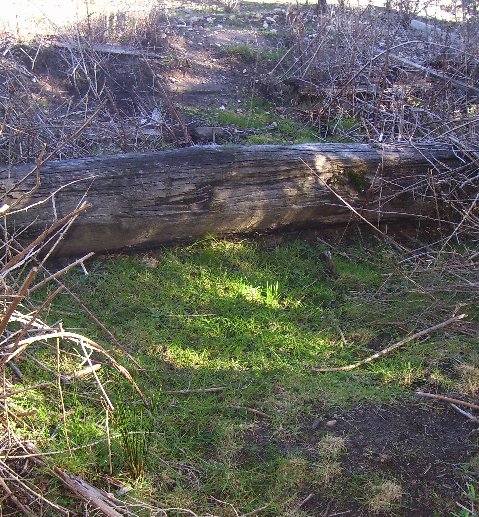| Pack |
Training:
To train a
goat to pack is
fairly easy. I probably would not be very good at teaching someone how
to train their goat to carry a pack, because ours do automatically.
When they are young kids, we tie things like a jacket or pair of
trousers around their middle while we milk one of the goats. When we
take it off, we pat them or give them a small handful of grain. When
they are about three months old, I put a real pack on them, and lead
them along, having trained them to lead at a few days old. They need a
bit of touching-up work with leading quietly for long periods of time,
but after a few days, they should be almost finished. Taking them out
among different things, such as cars, dogs, bikes and strangers will do
them good, and strengthen their faith in you. |
Price to train to kids: $5
Earliest age that kids can be trained: 1 month |
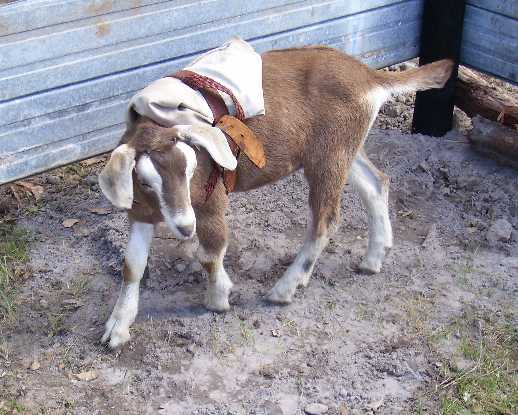 |
| Riding |
Training:
Riding
goats needs
to be carefully chosen as suitable, because goats are often small and
people
are often big. Bucks are fine to ride, as long as they are tame and
friandly, and preferably out of rut. Wethers obviousely don't come in
rut, but have the drawback of not growing as strong and heavy. Does are
alright if the rider is very small, they are only ridden for a short
time, and they are not heavily in kid. The same training applies for
teaching a goat to be ridden as to carry a pack, though they
will need a lot more training if they aren't just being led with
someone on their back. I train goats to respond to pressure on their
neck, as well as by reins. It helps future training to put a leg over
them and use your knees to make them obey the reins when they are a few
months old, though making sure not to put any weight on them when they
are
little. Using your knees to train them to 'Come on' / 'Walk on' as kids
also helps a lot, as they like to stop and don't like the idea of
working. It can be quite difficult to
make a goat accept a halter and reins, as they are used to having their
heads free, but if you constantly put a halter on their heads from
babyhood they will be much easier to train. Halters are not neccasary
however, if the rider knows wht they are doing and the goat is trained
to respond to touch. I push one hand on the side of their neck to turn
one way or the other, one hand on the front of their neck or pulling
their collar to slow down or stop, and hands on their shoulders and
legs in tighter to go. |
Price to train to kids: $5
Earliest age that kids can be trained: 3 months -properly by a year at least |
Here is a pic of Twinkle being ridden by Matthew
 |
| Harness |
Training:
Training
goats to harness
has two faces; training them to be led while pulling a cart, and
training to be driven. A working harness is extremely important, as if
your harness breaks or tangles or doesn't pull the cart or hold in
place, it can be a mess. There are many fancy harnesses you can buy, or
make a very simple one yourself. Get the two poles from the front of
the cart, use a staple gun to staple the ends of a wide, soft belt or
piece of very strong cloth to each pole, making a 'U' shape. Staple
another from the ends over where the goats shoulders will be, and
another just in front of where the hips will be. Staple the last one
inside the two poles around where the goat's back legs will be. Lift up
the poles, put the goats head through the front straps and straighten
the
goat in between the poles with the straps fitting snugly. An optional
strap can be a belt, cut in two, with one side stapled to one pole and
the other on the opposite pole with both facing down.
When the goat is in, the bottom strap can be secured to make the
harness totally secure. A travois, or even a branch, is useful for
traning them to pull, and to avoid risk of them running off or jumping
around and damaging a cart when they are learning. If they are being
led, it is rather simple from there, they only need to learn to walk
quietly at your side, and pull, and don't even need reins or a
halter/bridle. If
they are to be trained to be driven, they will need either a halter or
bridle, with long reins which should preferably go through some sort of
rings or grooves to stop them getting tangled. While being led to train
them to pull, they can be told "Left', 'Right', 'Whoa' or whatever they
are going to hear when in harness. They can also be driven by the reins
while being led
to train them to respond to the reins, and when they are obedient,
driven totally by the
reins.
For more information on cart goats, I would recomend these web
sites/pages:
UK Harness Society
I now have a real buggy/jinker thing, and two proper harnesses. I've
posted a few pics of different set-ups. |
Price to train to kids:
$15 (without reins)
$20 (with reins)
Earliest age that kids can be trained: 6 months |
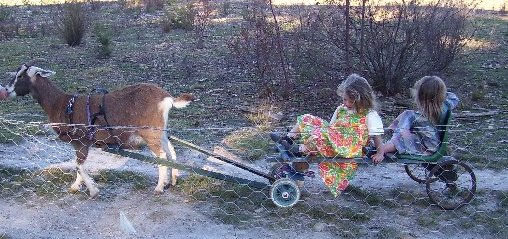
This
photo is of Tweedie pulling a training cart, and the harness was only a
temporay one. (notice the little wheels on the cart!) This cart has since been changed and is very useful.
Here is Sea with the Jinker on before it's overhaul. The
breastplate in this pic is also a bit low.
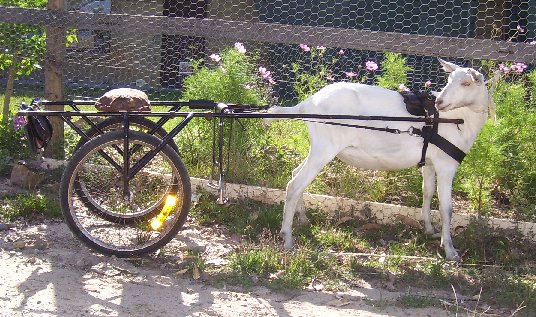
Twinks with the cart after renovating - it has been further
upgraded, but only very recently, with another basket below/behind the
seat for storing things.
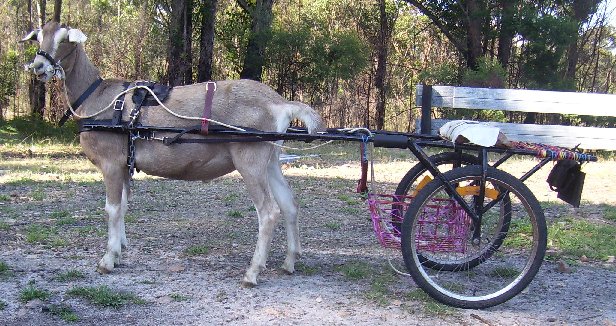 |
| Tricks |
Training:
There
are many different tricks that can be taught to goats, among them
kneel, rear, paw, shake hands, sit and lay.
Kneel
Here is what I wrote about how to train a goat
to kneel once:
(sorry about the grammer mistakes!)
"... to
train a goat to kneel, they need to be small, and the younger the
better - except they need to trust people and eat grain, so you should
probably train them from 1 month to about, maybe, four months, though I
did train one goat at 8 months, that was because we bought her as a bit
wild and didn't totally trust people (enough to do training anyway) for
a longish while, plus I hadn't trained any goats to kneel before that,
only rear and paw. The oldest goat I have trained to kneel was six
years old when I trained her. To train them to kneel, I get some grain
(oats or
barley) and put it in my pocket, then find a spot where there are no
other goats to steal it, get the goat I am going to train, and let it
smell the grain, then take the front legs and kneel them on the ground,
hold them until the goat is calm (if it has not already been trained to
let people hold it's legs) then, holding both front legs down with one
arm, get a handful of grain and feed it to the goat, though if it is
the first time (in other words, if we bought them) some goats refuse to
eat if I hold their legs. When they eat happily while kneeling, I let
go of their legs for a little while, then longer and longer as they
learn to stay kneeling while they eat. I repeat this process till they
only need me to pick up one hoof and they will kneel, (this is usually
the end of day 1's lessons) then soon enough they will kneel down when
I hold my hand on the ground and say "Kneel", then slowly I train them
to kneel when I hold my hand further and further off the ground, till I
only need to stand with my hand at my side and they will kneel without
any command. Though it sounds really complicated, it's not all that
hard if you have been with them a lot and they are tame, it also helps
a lot to kneel them down as really little babies, because they get very
touchy round their feet the older they get and can be very stubborn
even as two week olds!"
I also train kids to kneel down for their bottle of milk,
only letting them drink while kneeling down, and then they will kneel
down automatically for a handful of food. This way is a lot easier, and they can be trained by three days old.
Shake Hands
To
train a goat to shake hands, I hold some food
in my closed fist and say, "Shake", lifting their hoof while giving
them food. (sometimes they will paw at your hand by themselves to get
at the food) Goats catch on very quickly to this trick, as it is
natural
for them to paw at things to make a bed or break lids off containers of
food. To get them to shake, I hold my closed hand by my side
and
they will lift up their hoof.
Paw is the same training, they just paw your legs
instead. Paw can be annoying as they will often come up and
dig at you all the time to see if they can have a reward.
Rear
To
train a goat to rear, they should be quite young as after about a year
at most they are heavy and haven't developed the muscles in their back
legs. It is also not a good idea to get heavily pregnant does to rear.
For eager goats, I can usually just hold an arm straight out to the
side, and they will try rearing to get to it. For the less adventerous
ones, I often have to hold my hand against a wall or something else
that they can put their weight on. Eventually, I hold my hand further
away from the wall or object until they will rear straight up. While
training, it is important to make sure that the goat is in front of you
and facing towards your arm, otherwise they will try to rear on you.
Kids will be much better at this trick if they are trained very young,
otherwise they get heavy and don't have the muscles in their back legs.
After not doing this trick for a while, they often can't rear as high
or for nearly as long, as their leg muscles have weakened. A regular
(daily) excercise of this trick is probably best to keep them in
condition. To get them to rear, I hold my arm out sideways above their
heads.
Lay and Sit
I'll add
training info on these soon - basically, use a bottle or feed to train
them from kneel to lay, then lay to sit, and lastly, straight from
standing to sit. |
Price to train to kids:
Kneel: $5
Shake hands: $5
Rear: $5
Sit: $10 (when 'lay' is trained as well)
Lay: $5
Earliest age that kids can be trained: Two weeks for kneel/rear, 1 month for any combination of
these |
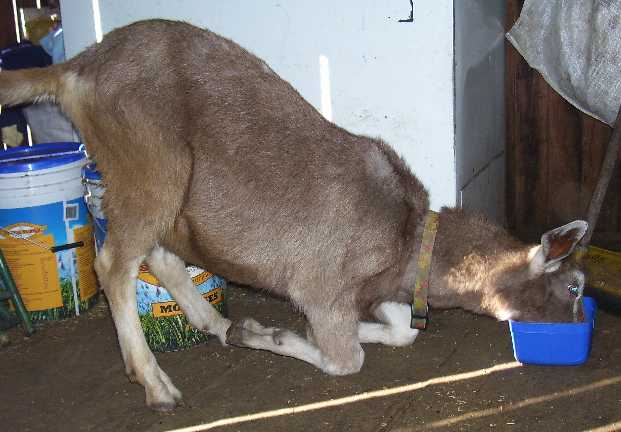
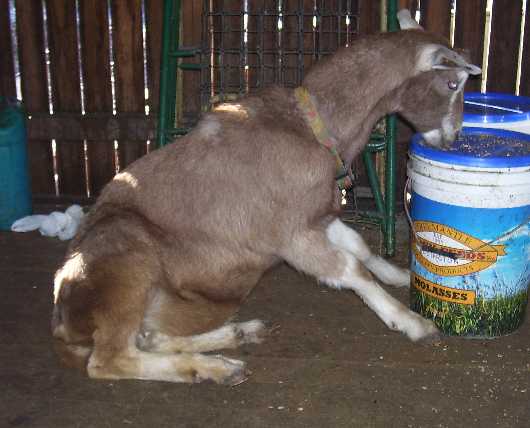
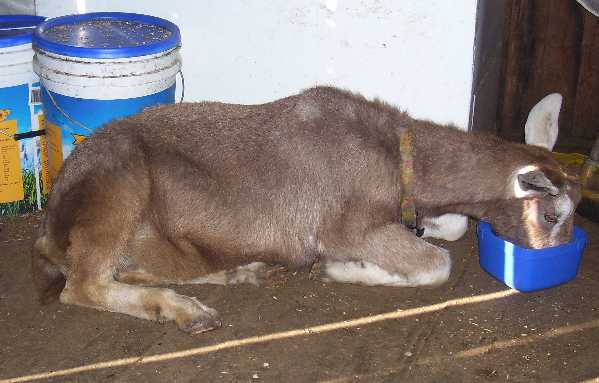
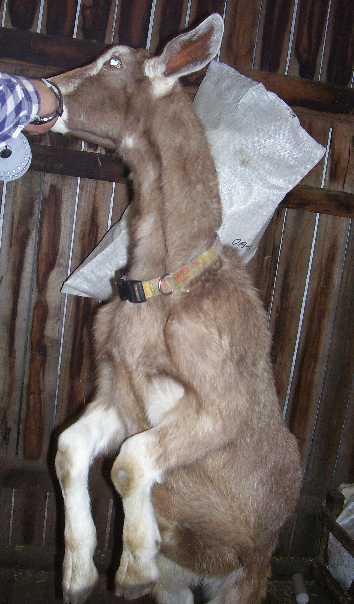
I don't have
any photos of a goat shaking hands at the moment, but I will get a
photo up when I can. |
